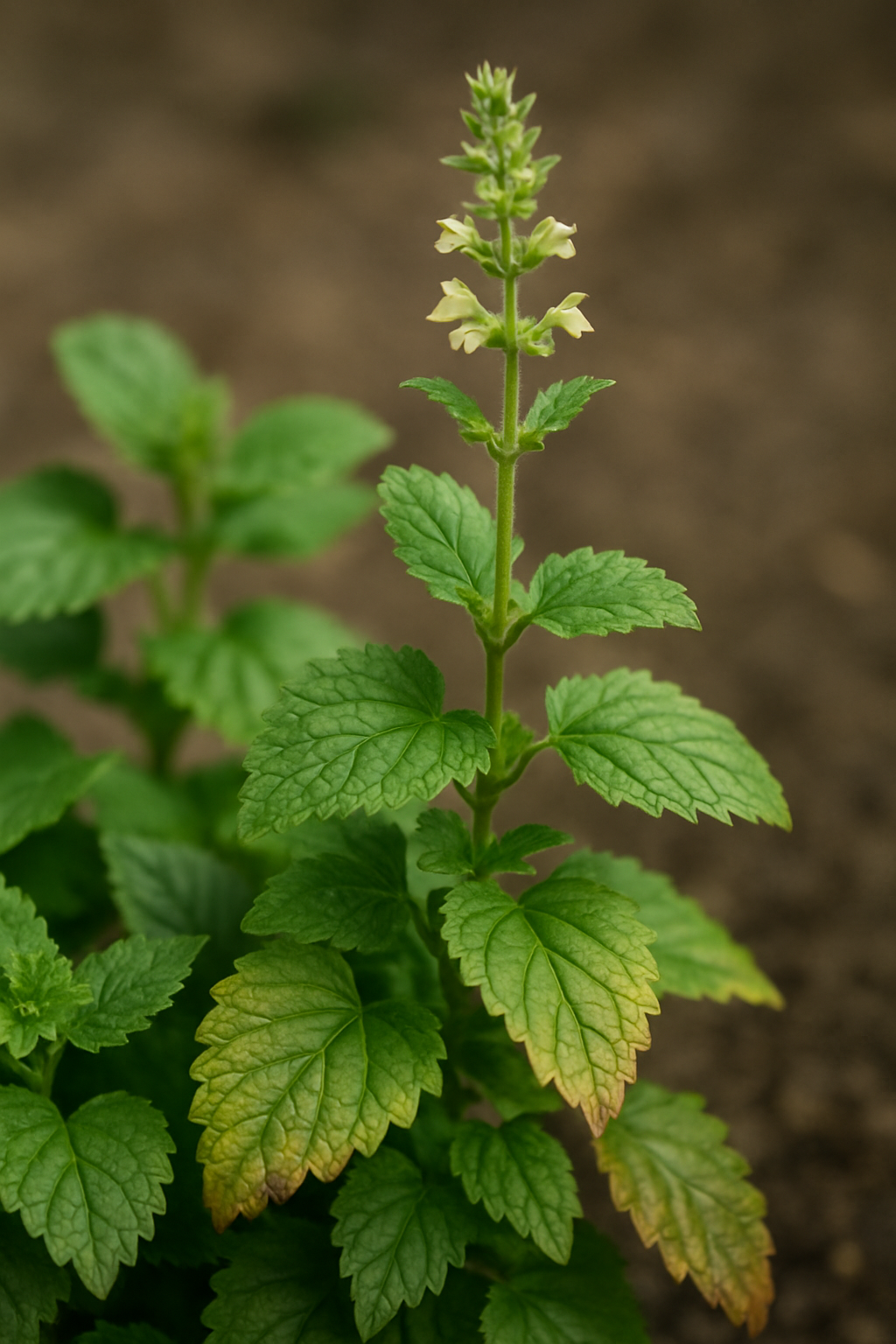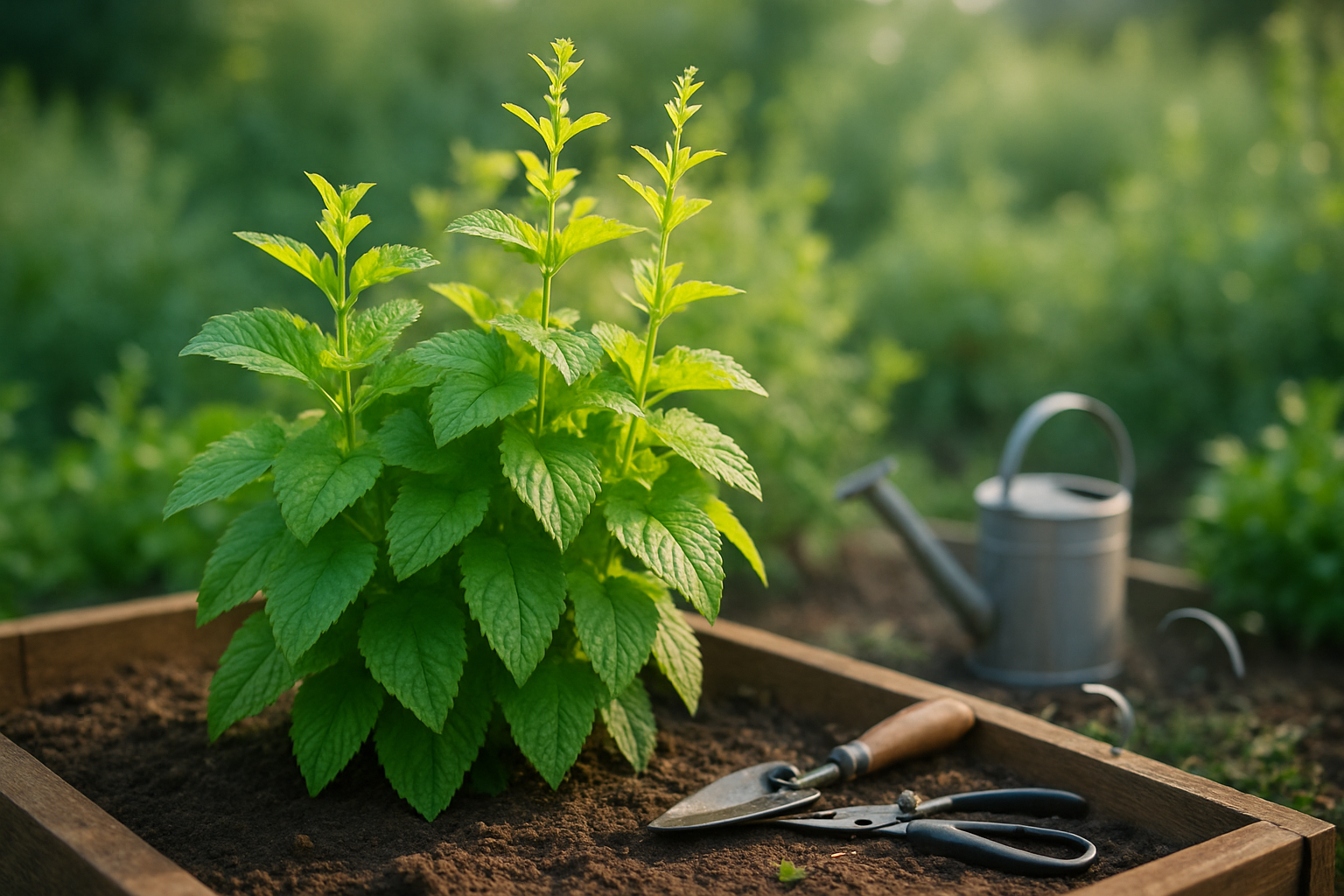Understanding Lemon Balm Bolting

Bolting in lemon balm refers to the rapid shift from leafy growth to flowering, usually triggered by longer daylight hours and warmer temperatures. This natural process is the plant’s way of completing its life cycle by producing flowers and, eventually, seeds.
You’ll know your lemon balm is starting to bolt when tall stems shoot up from the center, followed by small white or pale yellowish flowers forming at the tips. The leaves may become smaller, develop a tougher texture, and sometimes taste slightly bitter or less aromatic. These changes happen because the plant is redirecting energy from leaf production to flower and seed growth.
For gardeners who love lemon balm for its fresh, citrusy leaves, bolting can be a bit disappointing. This stage signals a slowdown in new, tender leaf growth and often a decline in overall leaf quality.
How to Delay Bolting
- Pinch off flower stems as soon as they appear.
- Keep the plant well-watered and partially shaded during the hottest part of the day.
- Regularly harvest leaves to slow the process.
However, once full flowering begins, there’s no way to reverse bolting. At that point, it’s best to cut back the plant or allow it to go to seed for next season.
Recognizing and managing bolting is key to enjoying flavorful lemon balm all summer long.
Why Lemon Balm Bolts
Lemon balm, like many herbs, bolts—or rapidly sends up flower stalks—when triggered by specific environmental cues. One of the main culprits is temperature: when spring shifts to summer and daytime temperatures climb above 75°F (24°C), plants interpret this as a signal to reproduce before heat stress sets in. Similarly, as days get longer, the increase in daylight hours prompts lemon balm to switch from leaf production to flower and seed development.
Stress factors such as drought, inconsistent watering, or sudden weather changes can accelerate this process, causing the plant to bolt prematurely in a desperate bid to ensure its survival. Maturity also plays a role; older, well-established plants are naturally more prone to bolting than young ones.
Not all lemon balm varieties respond the same way—some cultivated selections have been bred for delayed bolting and can tolerate warmer temperatures or longer days before flowering. For example, ‘Quedlinburger Niederliegende’ is a variety known for staying leafy longer than common types.
How to Reduce Bolting
- Keep lemon balm evenly moist.
- Plant it in a spot with partial shade during the hottest part of the day.
- Harvest leaves regularly to encourage vegetative growth.
Understanding these triggers and choosing bolt-resistant varieties helps gardeners maintain a lush, leafy lemon balm patch far longer through the growing season.
“`html
What To Do When Lemon Balm Flowers
When your lemon balm starts to flower, it’s a sign the plant is entering its bolting phase, which can cause the leaf flavor to decline. To manage this, act quickly by deadheading—pinch or snip off the flower spikes as soon as you notice them forming. This encourages the plant to focus its energy on producing lush, flavorful leaves instead of seeds.
Use clean scissors or pruners, cutting above a set of healthy leaves to promote bushier regrowth. Prune regularly, but avoid cutting more than one-third of the plant at a time to keep it healthy and vigorous.
If you want to support pollinators like bees or plan to collect seeds, let a few flower stalks bloom while deadheading most others. This way, you can attract beneficial insects without sacrificing your entire harvest.
After bolting begins, the leaves can turn bitter or lose their vibrant aroma, so harvest frequently and choose younger leaves for the best taste—older leaves tend to be tougher or bland. To preserve peak lemon balm flavor, trim the plant early in the morning, just after the dew dries, when essential oils are at their highest.
For a continual supply, try succession planting—starting new seeds every few weeks—to ensure fresh, sweet leaves throughout the season, even as older plants begin to flower.
With these steps, you can strike a balance between helping pollinators, gathering seeds, and keeping your lemon balm flavorful for teas, culinary uses, and remedies all summer long.
“`
How to Prevent Early Bolting

To prevent early bolting in lemon balm, start by staggering your planting times—a method called succession planting. Sow seeds in small batches every few weeks, allowing you to harvest leaves at their prime without worrying about all your plants flowering at once.
Keep your soil rich and well-drained by adding compost or organic matter before planting to boost nutrition and retain moisture. Consistent watering is crucial, especially during hot spells, since stress from dry soil often triggers bolting. Aim to water at the base of the plant early in the morning, keeping the foliage dry to reduce the risk of disease.
Plant lemon balm outdoors once the last frost has passed and nighttime temperatures reliably stay above 50°F (10°C), as cooler temperatures slow growth and reduce the risk of bolting. If you live in a warm climate, choose a spot with partial shade; too much direct sun can cause plants to flower prematurely.
For container-grown lemon balm, use a well-draining potting mix and a container with good drainage holes. Container soil dries out faster, so check moisture daily and water as needed, aiming for slightly damp but not soggy soil. Garden-grown lemon balm benefits from deeper soil and steadier moisture levels, but both types thrive when mulched—mulch conserves moisture and keeps roots cool, helping prevent the stress that leads to bolting.
Regularly pinch back growing tips to encourage bushier plants and delay flowering even further. By combining these simple cultural practices, you can enjoy lush lemon balm throughout the growing season.
Using Lemon Balm After It Bolts
Once lemon balm bolts, sending up tall stems dotted with tiny white flowers, many gardeners assume its best days are behind it—but that’s far from true. While the flavor of later-season leaves mellows, becoming less punchy than the fresh, pre-flowering growth, those leaves still offer a gentle lemony note that works beautifully in subtle teas, infused water, or as a fresh addition to fruit salads and herbed vinegars.
The flowers themselves attract pollinators and can be used as delicate edible garnishes on cakes, drinks, and savory dishes. Their soft floral taste complements everything from cocktails to honey. For medicinal uses, both flowers and bolted leaves retain calming properties—steep them together for a soothing digestive tea or add them to a relaxing bath.
Since the leaves are milder, consider mixing them with other fresh herbs like mint or basil when making pesto or herbal butters to round out the flavor. Looking ahead to next season, don’t miss the chance to save seeds: once the flowers fade and dry, gently shake the seed heads into an envelope for next year’s planting or simply let some stand in your garden to encourage natural reseeding.
By embracing every stage of lemon balm’s life cycle, you’ll extend both its harvest and its positive impact on your kitchen and wellness routines.
